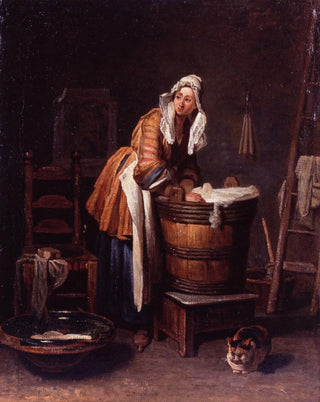Art print | Washing machine - Jean Siméon Chardin


View from behind

Frame (optional)
Art print Laveuse - Jean Siméon Chardin – Engaging Introduction
In the rich and captivating universe of art history, certain works stand out for their ability to capture the very essence of everyday life. "Art print Laveuse - Jean Siméon Chardin" is one of those creations that, through its apparent simplicity, immerses us in a moment of grace and contemplation. This canvas, created in the 18th century, bears witness to an era when genre painting held a prominent place in the artistic landscape. Chardin, with his keen eye and sensitivity, invites us to observe an ordinary scene, but one of timeless beauty. The washerwoman, the central figure of the work, embodies not only domestic labor but also the dignity and beauty of daily life.
Style and uniqueness of the work
Chardin's style is characterized by a realistic approach and meticulous attention to detail. In "Art print Laveuse," he manages to create an intimate atmosphere, where light plays a crucial role. The delicate nuances of the palette, ranging from warm tones to soft shadows, confer emotional depth to the scene. The composition, though simple, is skillfully orchestrated: the washerwoman, focused on her activity, is highlighted by a neutral background that emphasizes her presence. Chardin does not seek to idealize his subject but rather to celebrate the beauty of the ordinary. This realistic approach, far from the academic conventions of his time, marks a rupture and paves the way for a new appreciation of daily life.
The artist and his influence
Jean Siméon Chardin, born in 1699 in Paris, is often regarded as one of the masters of French painting. His work, though less well-known than that of his contemporaries such as Watteau or Boucher, had a significant impact on the development of modern painting. Chardin moved away from mythological and historical themes to focus on domestic life, thus revealing a unique sensitivity. His influence is felt among many later artists, notably the Impressionists, who also sought to capture moments of everyday life. The way Chardin pays homage to his subjects, endowing them with intrinsic dignity, helped redefine the

Matte finish

View from behind

Frame (optional)
Art print Laveuse - Jean Siméon Chardin – Engaging Introduction
In the rich and captivating universe of art history, certain works stand out for their ability to capture the very essence of everyday life. "Art print Laveuse - Jean Siméon Chardin" is one of those creations that, through its apparent simplicity, immerses us in a moment of grace and contemplation. This canvas, created in the 18th century, bears witness to an era when genre painting held a prominent place in the artistic landscape. Chardin, with his keen eye and sensitivity, invites us to observe an ordinary scene, but one of timeless beauty. The washerwoman, the central figure of the work, embodies not only domestic labor but also the dignity and beauty of daily life.
Style and uniqueness of the work
Chardin's style is characterized by a realistic approach and meticulous attention to detail. In "Art print Laveuse," he manages to create an intimate atmosphere, where light plays a crucial role. The delicate nuances of the palette, ranging from warm tones to soft shadows, confer emotional depth to the scene. The composition, though simple, is skillfully orchestrated: the washerwoman, focused on her activity, is highlighted by a neutral background that emphasizes her presence. Chardin does not seek to idealize his subject but rather to celebrate the beauty of the ordinary. This realistic approach, far from the academic conventions of his time, marks a rupture and paves the way for a new appreciation of daily life.
The artist and his influence
Jean Siméon Chardin, born in 1699 in Paris, is often regarded as one of the masters of French painting. His work, though less well-known than that of his contemporaries such as Watteau or Boucher, had a significant impact on the development of modern painting. Chardin moved away from mythological and historical themes to focus on domestic life, thus revealing a unique sensitivity. His influence is felt among many later artists, notably the Impressionists, who also sought to capture moments of everyday life. The way Chardin pays homage to his subjects, endowing them with intrinsic dignity, helped redefine the






